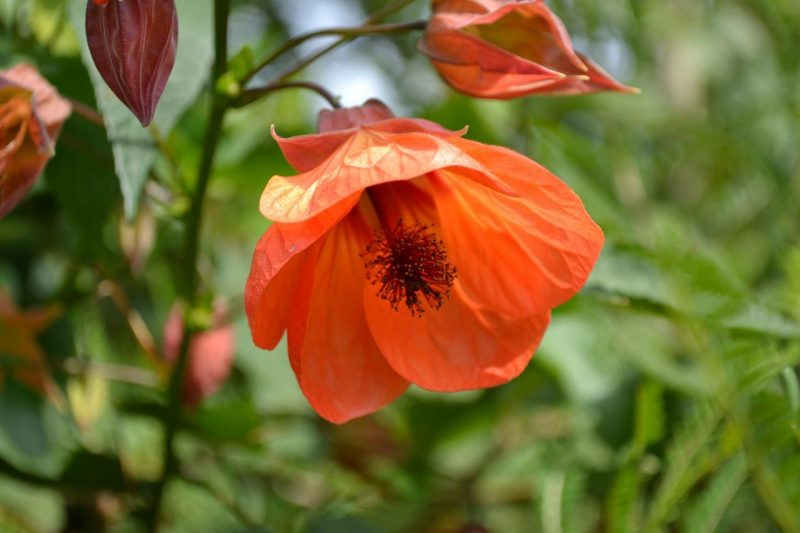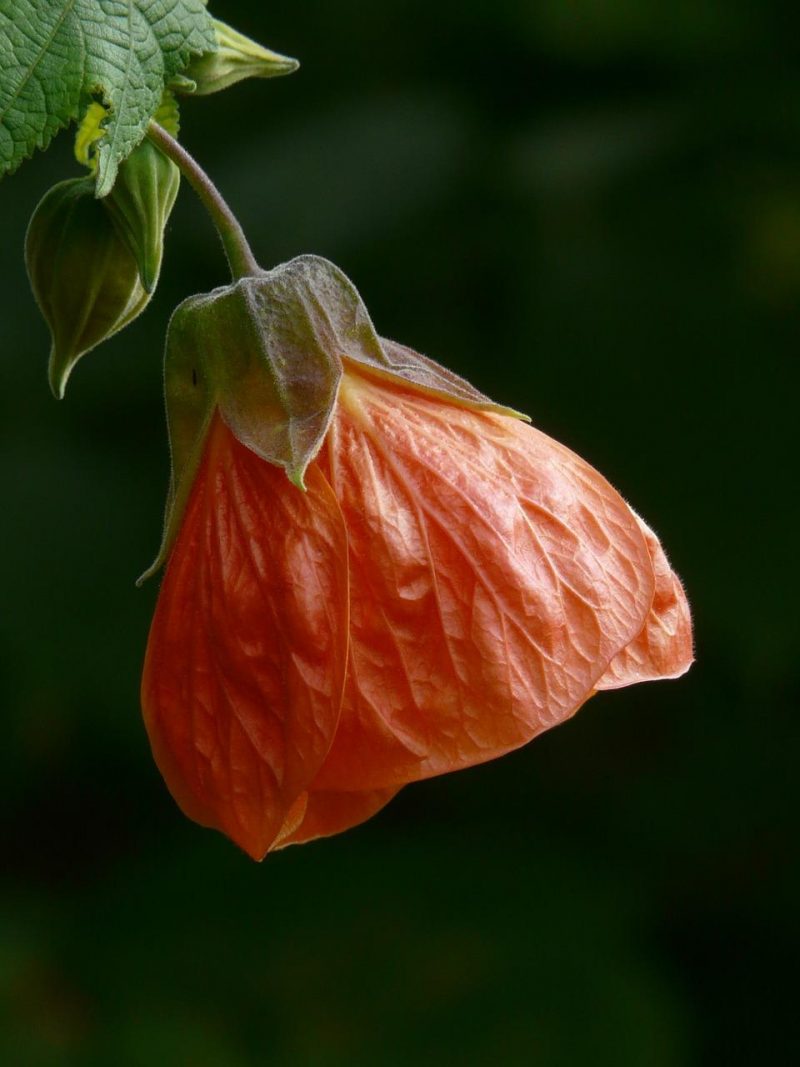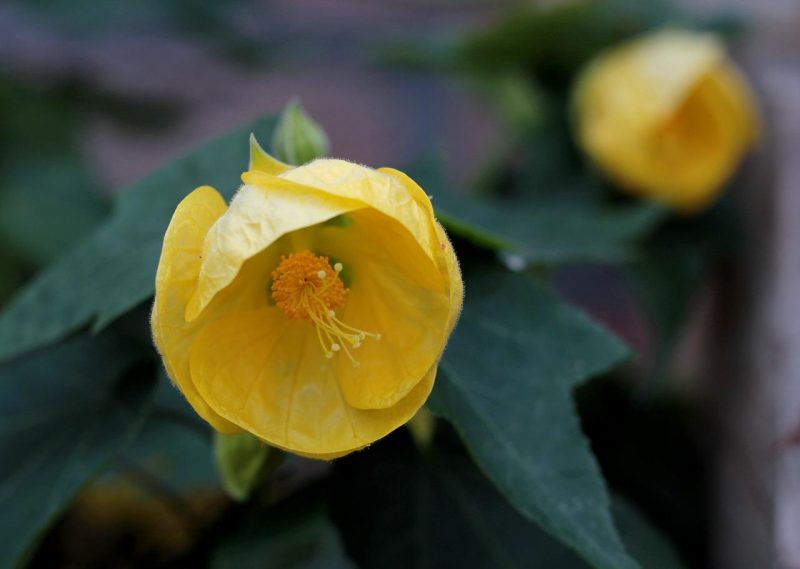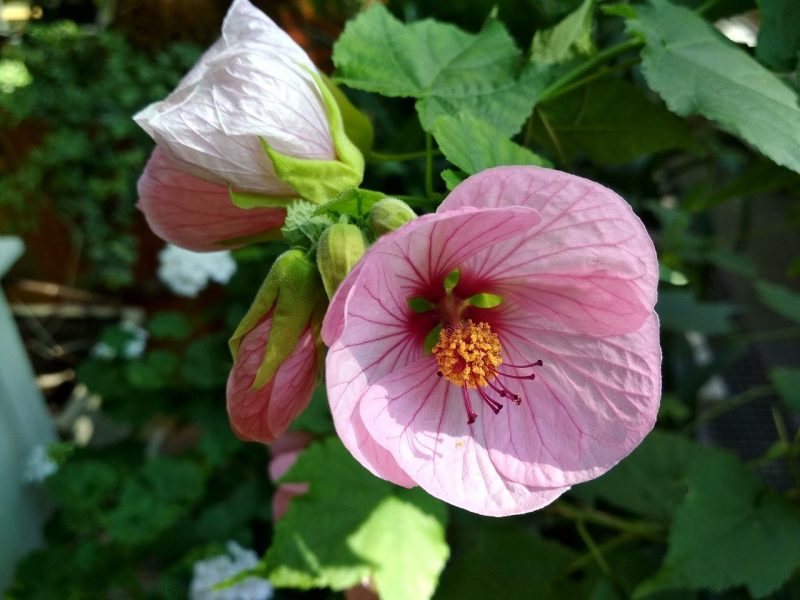Abutilon, plant care and growing guide

The genus Abutilon encompasses an extensive collection of approximately 200 species of ornamental plants, predominantly distributed across tropical and subtropical regions of the Americas, Africa, Asia, and Australia. These captivating plants are commonly referred to as “room maples” or “velvetleafs” owing to their resemblance to maple trees and their velvety leaf texture, respectively. Abutilon species exhibit remarkable versatility in their growth forms, encompassing perennial herbaceous plants, shrubs, and even small trees.



The leaves are palmate, lobed in some species, similar to maple (hence the popular name). However, they are not related to the maple. The flowers have 5 petals joined at the base, which gives the appearance of a bell or wheel. In most species, they are colored orange or yellow, but there are also species with red, pink, purple flowers.
It is a plant that blooms from spring to autumn if all its requirements are met.
Environment conditions
Light. Flowering plants should be kept in the sun or partial shade.
Temperature. It prefers moderate temperatures in the summer, and in the winter it needs a minimum of 10°C. It is excellent for keeping in pots, this being an advantage in winter when they must be moved inside. Also, the plants must be protected from frost and kept in a cool room, to ensure a period of rest.
Moisture. Abutilon plants have medium requirements for substrate moisture. They do not have special requirements for air humidity, but they can be sprayed from time to time with water on the leaves.
Substrates. It has no specific substrate preferences. It must allow for easy drainage of water and can be made of garden soil, gravel and sand.
Recommended products
-
You can find products on a different store
Change Store -
You can find products on a different store
Change Store -
You can find products on a different store
Change Store -
You can find products on a different store
Change Store -
You can find products on a different store
Change Store -
You can find products on a different store
Change Store -
You can find products on a different store
Change Store -
You can find products on a different store
Change Store -
You can find products on a different store
Change Store -
You can find products on a different store
Change Store -
You can find products on a different store
Change Store -
You can find products on a different store
Change Store -
You can find products on a different store
Change Store -
You can find products on a different store
Change Store -
You can find products on a different store
Change Store -
You can find products on a different store
Change Store -
You can find products on a different store
Change Store -
You can find products on a different store
Change Store -
You can find products on a different store
Change Store -
You can find products on a different store
Change Store -
You can find products on a different store
Change Store -
You can find products on a different store
Change Store -
You can find products on a different store
Change Store -
You can find products on a different store
Change Store
Watering
In the spring-autumn period, it is recommended to water abundantly to favor growth and flowering. During winter, the watering of the plants should be reduced, while avoiding complete drying of the substrate.
Fertilization
Abutilon plants require regular fertilization, from late winter to autumn.
Recommended products
-
You can find products on a different store
Change Store -
You can find products on a different store
Change Store -
You can find products on a different store
Change Store -
You can find products on a different store
Change Store -
You can find products on a different store
Change Store -
You can find products on a different store
Change Store -
You can find products on a different store
Change Store -
You can find products on a different store
Change Store -
You can find products on a different store
Change Store -
You can find products on a different store
Change Store -
You can find products on a different store
Change Store -
You can find products on a different store
Change Store -
You can find products on a different store
Change Store -
You can find products on a different store
Change Store -
You can find products on a different store
Change Store -
You can find products on a different store
Change Store -
You can find products on a different store
Change Store -
You can find products on a different store
Change Store -
You can find products on a different store
Change Store -
You can find products on a different store
Change Store -
You can find products on a different store
Change Store -
You can find products on a different store
Change Store -
You can find products on a different store
Change Store -
You can find products on a different store
Change Store
Repotting
Repotting is the process of transferring a plant to a new pot that is larger to accommodate its growth. It is typically done in the spring when the plant is actively growing. The frequency of repotting depends on the plant’s growth rate.
When repotting, choose a slightly larger pot with drainage holes. Fill the pot with well-draining potting mix. Gently loosen the roots of the plant and place it in the new pot. Fill the space around the roots with fresh potting mix. Firmly press the potting mix to secure the plant and water thoroughly to settle the soil.
Repotting is essential for plant growth and provides an opportunity to check for pests or diseases.
Propagation
Abutilon can be propagated both by cuttings and by seeds. For cuttings, cut shoots between 8-10 cm in size, in spring-summer. The heat causes them to take root quickly.
The seeds are sown in spring and germinate in about 3 weeks. It can take up to a year for the plant obtained from the seeds to bloom.
Recommended products
-
You can find products on a different store
Change Store -
You can find products on a different store
Change Store -
You can find products on a different store
Change Store -
You can find products on a different store
Change Store -
You can find products on a different store
Change Store -
You can find products on a different store
Change Store -
You can find products on a different store
Change Store -
You can find products on a different store
Change Store -
You can find products on a different store
Change Store -
You can find products on a different store
Change Store -
You can find products on a different store
Change Store -
You can find products on a different store
Change Store -
You can find products on a different store
Change Store -
You can find products on a different store
Change Store -
You can find products on a different store
Change Store -
You can find products on a different store
Change Store -
You can find products on a different store
Change Store -
You can find products on a different store
Change Store -
You can find products on a different store
Change Store -
You can find products on a different store
Change Store -
You can find products on a different store
Change Store -
You can find products on a different store
Change Store -
You can find products on a different store
Change Store -
You can find products on a different store
Change Store
Pruning
Abutilon tends to grow a lot, so to maintain a dense and compact bush, it is necessary to make branch cuts. Moreover, this will stimulate the growth of new shoots and more abundant flowering.
In general, pruning should be done in early spring. To stimulate a new shoot and flowering, it is advisable to shorten the branches even after the flowering period.
Recommended products
-
You can find products on a different store
Change Store -
You can find products on a different store
Change Store -
You can find products on a different store
Change Store -
You can find products on a different store
Change Store -
You can find products on a different store
Change Store -
You can find products on a different store
Change Store -
You can find products on a different store
Change Store -
You can find products on a different store
Change Store -
You can find products on a different store
Change Store -
You can find products on a different store
Change Store -
You can find products on a different store
Change Store -
You can find products on a different store
Change Store -
You can find products on a different store
Change Store -
You can find products on a different store
Change Store -
You can find products on a different store
Change Store -
You can find products on a different store
Change Store -
You can find products on a different store
Change Store -
You can find products on a different store
Change Store -
You can find products on a different store
Change Store -
You can find products on a different store
Change Store -
You can find products on a different store
Change Store -
You can find products on a different store
Change Store -
You can find products on a different store
Change Store -
You can find products on a different store
Change Store
Pests
Especially when kept indoors, abutilon plants can be attacked by whitefly, mites and aphids.
Recommended products
-
You can find products on a different store
Change Store -
You can find products on a different store
Change Store -
You can find products on a different store
Change Store -
You can find products on a different store
Change Store -
You can find products on a different store
Change Store -
You can find products on a different store
Change Store -
You can find products on a different store
Change Store -
You can find products on a different store
Change Store -
You can find products on a different store
Change Store -
You can find products on a different store
Change Store -
You can find products on a different store
Change Store -
You can find products on a different store
Change Store -
You can find products on a different store
Change Store -
You can find products on a different store
Change Store -
You can find products on a different store
Change Store -
You can find products on a different store
Change Store -
You can find products on a different store
Change Store -
You can find products on a different store
Change Store -
You can find products on a different store
Change Store -
You can find products on a different store
Change Store -
You can find products on a different store
Change Store -
You can find products on a different store
Change Store -
You can find products on a different store
Change Store -
You can find products on a different store
Change Store
In addition:
- abutilon flowers attract butterflies;
- in general, hybrids rarely produce fruit. The species, however, produces fruit. These are represented by a round / hemispherical schizocarp, made up of several segments inside which there are several seeds.















































































































































































































































































































































































































































